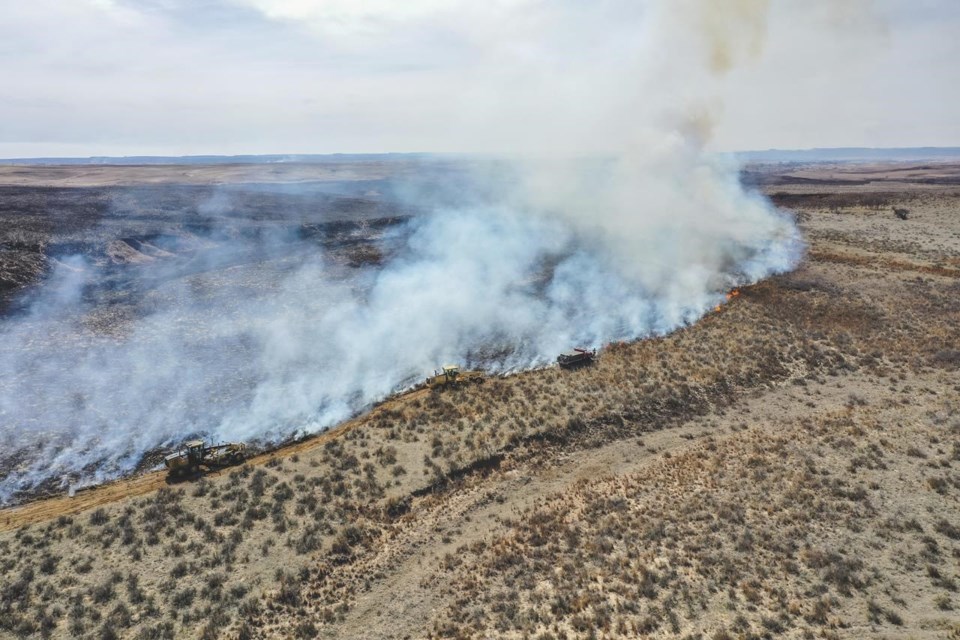McALLEN, Texas (AP) — Planes dropped fire retardant over the Texas Panhandle on Sunday and a small community was ordered to evacuate as firefighters kept up efforts to stamp out the largest wildfire in state history while contending with new blazes.
Strong winds spread the flames further, prompting an evacuation order to be issued in Sanford, a town of a little more than 100 residents, according to the Amarillo office of the National Weather Service, which posted on X. A cluster of fires has burned more than 1,900 square miles (4,900 square kilometers) in rural areas surrounding Amarillo, including the largest blaze spilling into neighboring Oklahoma.
As firefighters battle to contain the unprecedented , humanitarian organizations are pivoting their attention to victims who have lost their homes and livelihoods in the blazes.
Residents began clearing affected property on Saturday, and by Sunday the extent of the loss began mounting.
Julie Winters, the executive director for Hutchinson County United Way, said the organization has heard estimates of over 150 homes in the county, noting that the fires extend to at least five other counties.
“We already know that a large group of people are uninsured who lost their homes. So without monetary assistance, it’s going to be very hard for them to start back over,” Winters said.
About 70 families from Fritch, Texas, approached the organization on Friday during an event, but Winters believes many others will come forward in the days and weeks ahead.
“Our goal is just for the long term of trying to get people back into shelters,” Winters said.
A steady outpouring of donated clothing, water, and hot meals quickly overwhelmed one city in the affected area. By Sunday, the city of Borger urged people to redirect their donation efforts from food and water to clean-up supplies.
“We DO NOT NEED ANY MORE WATER OR DRINKS,” the city said in a social media post. “We remain in need of clean-up material such as shovels, rakes, gloves, and heavy-duty trash bags. We continue not accepting clothing. Other clothing drop-off places have been inundated and have stopped accepting.”
Monetary donations from people ranging from $25 to $500 have been critical for the Hutchinson County United Way Wildfire Relief Fund, which is dispersing proceeds to displaced families.
“I think sometimes what people don’t understand in a small rural community is that there is no temporary housing,” Winters said. “We don’t have real property like that and we don’t even have hotels that can take care of those things.”
Winters said the fires remind her of the similar devastating effects from the 2014 fire in Fritch when numerous families also lost their homes and were unable to return.
“How do you get people back into homes so that they can stay in our community and not have to move somewhere else?” Winters said.
During an interview with CNN on Sunday, U.S. Homeland Security Secretary Alejandro Mayorkas said the federal government has devoted funds, equipment and personnel to assist with battling the fires, but warned that more extreme weather could be coming.
“More than a million acres have burned. And we are in winter, and this is the largest fire in Texas history," Mayorkas said. “We, as a country and as a world, have to be ready for the increasing effects of . It’s a remarkable phenomenon, and it will manifest itself in the days to come, and we have to prepare for it now.”
As of Sunday afternoon, the Smokehouse Creek fire, which has burned over 1 million acres, was 15% contained. Two other fires that have burned a combined 180,000 acres (72843.49 hectares), were 60% contained. Authorities have not said what ignited the fires, but strong winds, dry grass and fed the blazes.
The National Weather Service issued red flag warnings — signifying extreme fire risk due to warm temperatures, low humidity and strong winds — across much of the central U.S. on Sunday, including Texas and its neighboring states of New Mexico and Oklahoma. Red flag warnings also covered nearly all of Nebraska and Iowa, along with large swaths of Kansas, Missouri and South Dakota. Smaller portions of Colorado, Wyoming, Minnesota and Illinois were also under red flag warnings.
___
Associated Press writer Thomas Strong contributed to this story from Washington, D.C., and Trisha Ahmed from Minneapolis.
Valerie Gonzalez, The Associated Press



